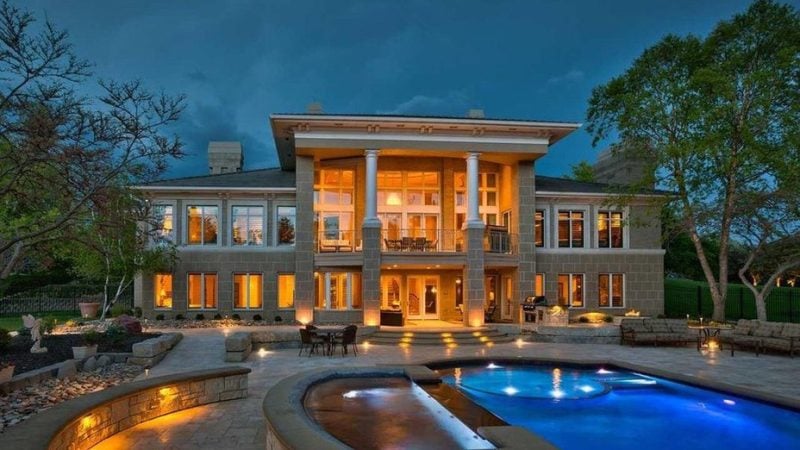The 30 Best Places to Live in Massachusetts: Top Communities

Massachusetts offers residents a unique combination of rich historical heritage, academic excellence, and diverse communities that make it one of the most sought-after states in New England.
From vibrant urban centers to quiet suburban neighborhoods, the Bay State provides options for every lifestyle and budget preference.
This comprehensive ranking evaluates Massachusetts communities based on critical factors including public school quality, safety ratings, cost of living, employment opportunities, and local amenities to help prospective residents make informed decisions.
The analysis covers major cities like Boston and Cambridge alongside smaller communities that offer exceptional quality of life, examining everything from housing costs to cultural attractions and transportation access.
Here are the 30 best places to live in Massachusetts:
30. Gloucester

Gloucester sits on Massachusetts’ eastern coast, just 32 miles from Boston. The city offers residents a dense suburban atmosphere with a population of nearly 30,000 people.
Most residents own their homes in this Essex County community. The area attracts young professionals and retirees who appreciate the coastal setting.
Gloucester’s median household income reaches $76,260, exceeding the national average. The poverty rate stands at 9.6%, which is notably lower than national figures.
The city features numerous restaurants, coffee shops, and parks for residents. Public schools in Gloucester perform above average compared to state standards.
Home prices align with Massachusetts averages around $477,554. The community maintains a vibrant artistic scene and active harbor district.
Gloucester provides easy access to Boston while offering a quieter coastal lifestyle. Residents enjoy both suburban amenities and scenic waterfront views.
29. Manchester-by-the-Sea
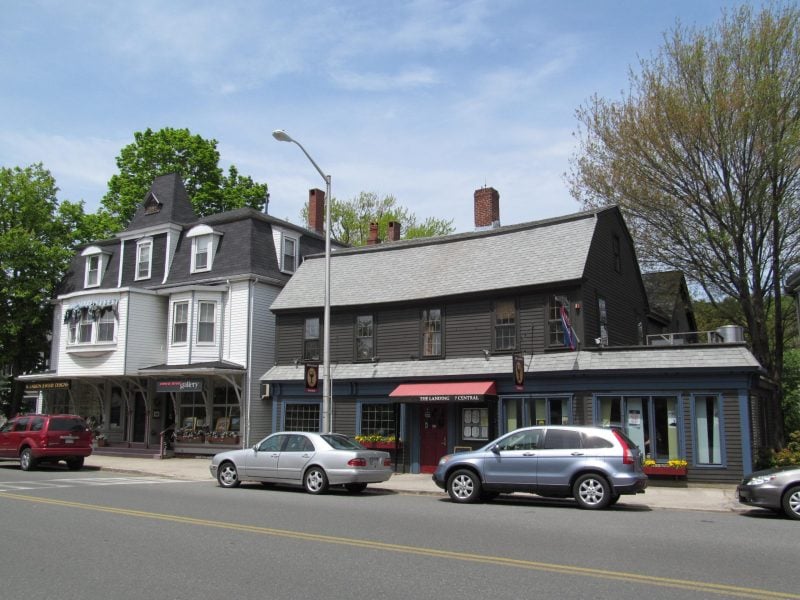
Manchester-by-the-Sea sits on Massachusetts’ North Shore, just 40 minutes from Boston. This coastal town houses approximately 5,368 residents in Essex County.
The community offers a sparse suburban atmosphere with strong homeownership rates. Residents enjoy access to numerous parks and recreational facilities throughout the area.
Manchester-by-the-Sea provides excellent safety ratings and consistently ranks among Massachusetts’ top places to live. The town maintains a close-knit, family-friendly environment.
Two beaches serve the community, including White Beach with views toward Boston’s skyline. The downtown area features local restaurants, shops, and historic sites.
The location provides easy access to both coastal amenities and urban conveniences. Manchester-by-the-Sea appeals to families seeking a quiet New England seaside lifestyle within commuting distance of Boston.
28. Dover
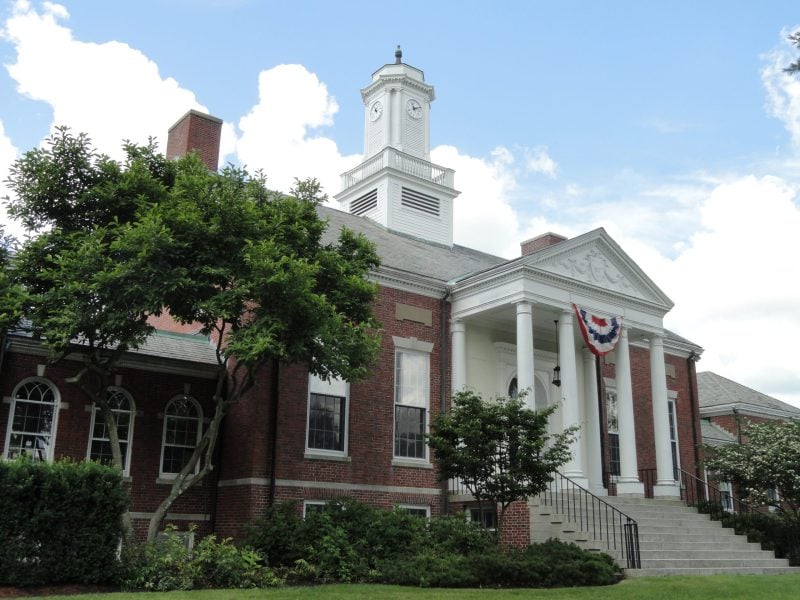
Dover stands as one of Massachusetts’ premier suburban communities with a population just over 6,000 residents. This small Norfolk County town offers a peaceful residential atmosphere that attracts families seeking quality living.
The town’s public school system earns consistently high ratings, making it particularly appealing to parents. Dover’s educational excellence contributes significantly to its reputation as a top-tier community.
Residents enjoy a classic New England suburban environment with tree-lined streets and well-maintained properties. The town maintains its small-town character while providing access to modern amenities and services.
Dover’s location provides convenient access to Boston and surrounding metropolitan areas. This proximity allows residents to enjoy suburban tranquility while maintaining reasonable commuting options to urban employment centers.
The community emphasizes safety and maintains low crime rates. Dover’s combination of excellent schools, safe neighborhoods, and suburban charm makes it a sought-after destination for Massachusetts families.
27. Westwood
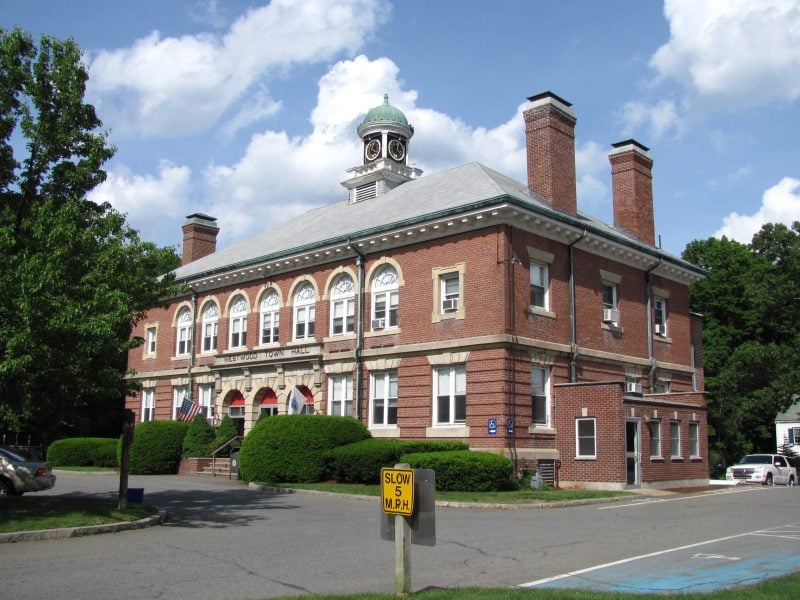
Westwood stands out as one of Massachusetts’ premier suburban communities in Norfolk County. The town has a population of approximately 16,213 residents and offers a dense suburban atmosphere.
The community ranks highly for its exceptional school system with an average rating of 9. Crime rates remain well below both metro and national averages, making it particularly attractive to families.
Housing costs reflect the area’s desirability, with median home prices reaching $755,400. The cost of living sits 44% above the national average, positioning Westwood as a premium residential choice.
Residents benefit from convenient access to the Route 128 corridor for commuting. The town features numerous coffee shops, parks, and recreational trails throughout tree-lined neighborhoods.
Westwood provides easy access to Greater Boston while maintaining its suburban character. The community has received recognition from Boston Magazine as one of the top places to live in the region.
26. Burlington
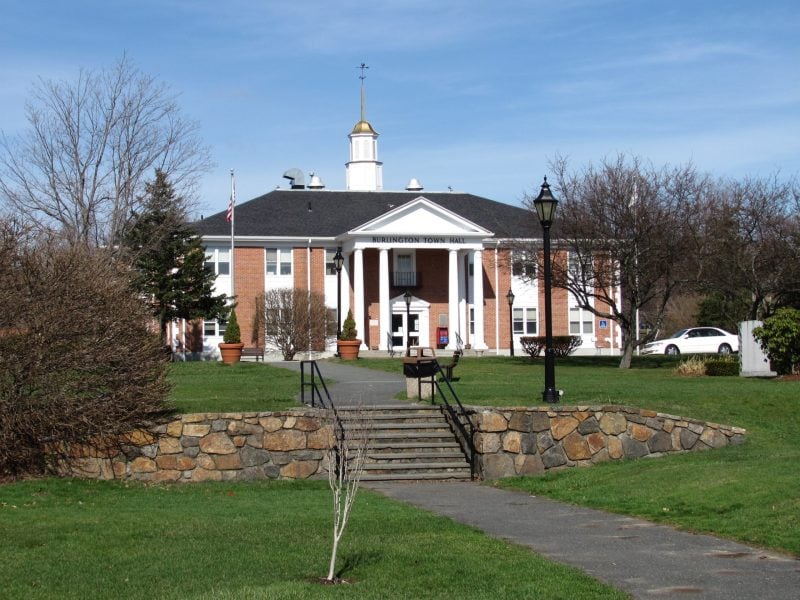
Burlington stands as one of Massachusetts’ premier suburban communities, located just twelve miles from Boston in Middlesex County. The town serves 26,223 residents with a dense suburban atmosphere where most people own their homes.
The community boasts impressive economic indicators. The typical household earns $121,433 annually, nearly double the national median. The poverty rate sits at just 4.2%, significantly below national averages.
Burlington receives high marks for livability with a score of 72 out of 100. The town maintains low crime rates and good air quality, making it particularly attractive for families.
Educational excellence defines the community. Public schools rank well above state averages and are considered among Massachusetts’ best institutions.
Residents enjoy abundant dining options, coffee shops, and parks throughout the area. The commute to downtown Boston typically takes 30 to 40 minutes by car.
25. Watertown

Watertown ranks as one of Massachusetts’ top suburbs, placing 30th out of 6,805 for young professionals according to recent data. This Boston suburb houses 35,270 residents in Middlesex County.
The town offers an urban-suburban blend that attracts diverse demographics. Most residents choose to rent rather than own their homes.
Watertown provides abundant dining options, coffee shops, and parks throughout the community. The area maintains low crime rates and fosters a family-friendly atmosphere.
Home prices exceed the state average of $477,554, reflecting the area’s desirability. The town’s proximity to Boston creates convenient commuting options for professionals.
Rich history combines with modern amenities to create appeal for potential residents. Green spaces and growing luxury apartment developments enhance the living experience.
Multiple ranking organizations recognize Watertown among Massachusetts’ best places to live.
24. Sudbury
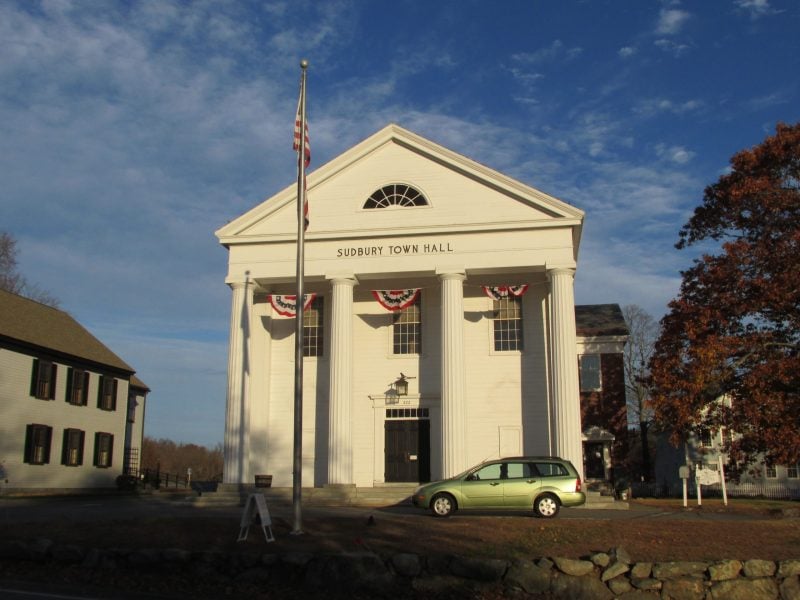
Sudbury sits about 22 miles west of downtown Boston, offering residents a prosperous suburban lifestyle. The town has a population of approximately 18,400 people and ranks among the top 20 safest cities in Massachusetts.
The public school system receives high ratings, with Lincoln-Sudbury High School ranking among the top 10 in the state. This educational quality attracts many families to the area.
Housing costs vary significantly in Sudbury. Average rent remains affordable at $569 per month, though home values are considerably higher at around $640,700.
The town provides a welcoming environment with beautiful neighborhoods and strong community connections. Residents enjoy recreational opportunities and a high quality of life in this New England setting.
Sudbury’s location offers easy access to Boston while maintaining a quiet, upscale atmosphere throughout the community.
23. Weston

Weston stands as one of Massachusetts’ most affluent suburban communities, located just 30 minutes from downtown Boston in Middlesex County. This historic New England town offers residents a sparse suburban feel with a population of approximately 11,443.
The community attracts families, retirees, and professionals seeking high-quality schools and safe neighborhoods. Most residents own their homes in this desirable Boston suburb.
Weston provides abundant outdoor recreation opportunities with roughly 1,800 acres of conservation land preserved as parks and hiking trails. The town appeals particularly to nature enthusiasts and families with children who enjoy outdoor activities.
The area features well-preserved colonial architecture and a picturesque downtown with shopping and dining options. While not known for vibrant nightlife, Weston compensates with its peaceful atmosphere and natural beauty.
Residents tend to be liberal-leaning, creating a cohesive community environment. The town’s proximity to Boston combined with its suburban tranquility makes it attractive to those seeking small-town charm with urban accessibility.
22. Winchester
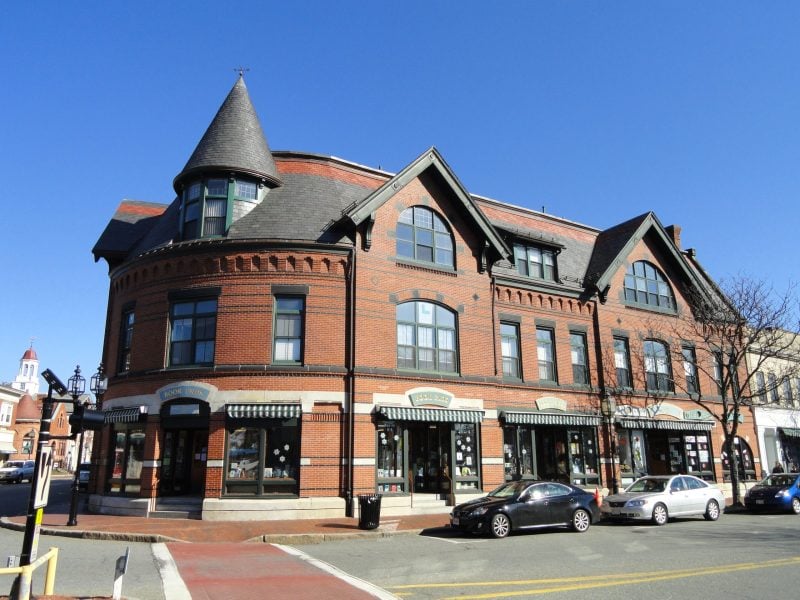
Winchester stands as one of Massachusetts’ premier suburban communities, located just 8 miles north of Boston in Middlesex County. The town houses approximately 22,862 residents who enjoy excellent access to urban amenities while maintaining a peaceful residential atmosphere.
The community offers exceptional educational opportunities through its highly-ranked public school system. Parents frequently choose Winchester specifically for these academic advantages, making it particularly attractive to families with school-age children.
Housing costs reflect the area’s desirability, with median single-family home prices reaching $1.5 million. Most residents own their homes, contributing to neighborhood stability and community investment.
Winchester provides numerous coffee shops, parks, and recreational spaces that foster community connections. The town’s historic character adds charm while modern conveniences ensure comfortable daily living.
Safety ratings consistently rank among the state’s best, giving residents peace of mind. The combination of low crime rates, quality schools, and proximity to Boston creates significant appeal for professionals and families seeking suburban living.
21. Southborough

Southborough stands out as one of Worcester County’s most affluent communities. This suburban town maintains a quiet, rural atmosphere while offering convenient access to Boston.
The town earned recognition when CNN Money ranked it 31st on their “100 Best Places to Live” list in 2009. Niche.com has given Southborough an A+ rating as one of Massachusetts’ top residential areas.
With a population of approximately 10,450, Southborough attracts families seeking excellent schools and safe neighborhoods. The community features scenic roads, reservoirs, and abundant open space that enhance its historic village center.
Residents enjoy seasonal celebrations like the Fall Festival and can visit attractions such as the Butterfly Garden and Stonehouse Pond. The town offers numerous restaurants, coffee shops, and parks for daily amenities.
Two prestigious boarding schools contribute to the area’s educational reputation. Most residents own their homes in this desirable Worcester County location.
20. Milton

Milton stands out as a desirable suburb located just south of Boston in Norfolk County. The town combines rich historical heritage with a cozy small-town atmosphere while maintaining easy access to the city.
Money Magazine recognized Milton as the 17th best place to live in the country. The ranking highlighted the community’s small-town feel, good schools, and low crime rates.
Milton offers residents quality educational opportunities and a strong job market. The Blue Hill Observatory & Science Center serves as a notable local attraction and educational resource.
Housing costs remain relatively affordable compared to other Boston suburbs. The town’s proximity to Boston provides excellent employment opportunities while offering a quieter residential environment.
Most neighborhoods in Milton are highly desirable, though some northwestern areas are considered less premium. The community maintains strong property values and attracts families seeking suburban living near Boston.
19. Natick
Natick stands as one of Massachusetts’ premier suburban communities in Middlesex County. The town offers residents a dense suburban atmosphere with a population of 36,627 people.
Most residents own their homes in this Boston suburb. The community provides excellent access to restaurants, coffee shops, and parks throughout the area.
Natick ranks among the best places to live in Massachusetts based on multiple factors. The town scores well for cost of living, safety measures, education quality, and job market opportunities.
Residents enjoy recreational activities at Cochituate State Park. The popular Natick Mall provides shopping options for the community.
The town’s location offers convenient access to Boston while maintaining a suburban feel. Housing quality varies significantly across different neighborhoods within Natick, with some areas commanding higher home values than others.
18. Hopkinton
Hopkinton sits 26 miles west of Boston in Middlesex County, offering residents a peaceful suburban lifestyle with city access. This charming town spans approximately 28.2 square miles and maintains a strong sense of community.
The town gained national recognition as the official starting point of the Boston Marathon. Hopkinton State Park provides over 1,200 acres of recreational space for outdoor enthusiasts.
Several magazines have recognized Hopkinton as one of Massachusetts’ best places to live. The town features excellent schools and attracts families seeking quality education for their children.
Home prices in Hopkinton exceed the state average of $477,554, reflecting the area’s desirability. The community blends historic New England charm with modern amenities and conveniences.
Public transportation and highway access keep residents well-connected to the greater Boston area. Young professionals and families find the town’s mix of rural charm and suburban amenities particularly appealing.
17. Andover
Andover ranks among the best places to live in Massachusetts, located conveniently in Essex County with a population of approximately 36,000 residents. The town offers a dense suburban feel where most residents own their homes.
The community benefits from excellent schools that consistently rank among the state’s best. Phillips Academy, one of the nation’s most prestigious prep schools, calls Andover home.
Location advantages include proximity to major highways like I-95, I-93, and I-495. Residents can reach coastal areas, New Hampshire, and Boston within 30 minutes by car or train.
The median household income reaches $113,684, significantly higher than the national average. The poverty rate sits at 6.9%, well below national levels.
Andover features numerous coffee shops and parks throughout the community. The competitive real estate market reflects the town’s desirability among families and professionals seeking quality suburban living.
16. Acton
Acton stands as one of Massachusetts’ premier suburban communities, located 21 miles northwest of Boston. This Middlesex County town offers residents the perfect blend of suburban tranquility and urban accessibility.
The town serves 23,961 residents with exceptional educational opportunities. Families benefit from six elementary schools, plus quality middle and high school options that attract parents seeking top-tier education.
Acton provides a dense suburban atmosphere where most residents own their homes. The community features numerous coffee shops and parks that enhance daily life for families and professionals alike.
Housing costs exceed the Massachusetts average of $477,554, reflecting the town’s desirability and strong market demand. The higher prices indicate neighborhoods where people actively choose to live and invest.
The town attracts liberal-leaning residents who value community engagement and family-friendly amenities. Acton’s growing popularity in the real estate market demonstrates its appeal as a Boston suburb.
15. Concord
Concord stands as one of Massachusetts’ most desirable suburban communities with a population of 18,226 residents. This Middlesex County town offers an ideal blend of historical significance and modern living amenities.
The community receives exceptional ratings across multiple categories. Education scores rank 9 out of 10, while amenities also earn a 9 out of 10 rating from residents and experts.
Concord’s downtown area provides excellent walkability for daily activities. The town features numerous coffee shops, parks, and well-maintained public spaces that enhance quality of life.
Historic sites and cultural attractions make Concord particularly appealing to history enthusiasts. The town played a significant role in the Revolutionary War and served as home to many prominent American authors.
Most residents own their homes in this dense suburban environment. The community maintains its small-town character while providing easy access to Boston’s metropolitan amenities.
14. Needham
Needham ranks consistently among Massachusetts’s top places to live. This Norfolk County town of 31,177 residents earns recognition for its exceptional quality of life and educational opportunities.
The community maintains a remarkably low crime index of 23, well below both metro and national averages. This makes it particularly attractive for families seeking a safe environment.
Needham’s school system receives an average rating of 8, reflecting the town’s commitment to education. The poverty rate stands at just 2.4%, which is 83% lower than the national average.
The typical household earns $174,707 annually, significantly higher than the national median of $67,500. However, this prosperity comes with elevated housing costs, as the median home value reaches $1,406,200.
The town offers various neighborhoods with distinct characteristics and price points. Housing quality varies considerably across different areas, providing options for different budgets and preferences.
13. Framingham
Framingham stands out as one of Massachusetts’ most desirable communities with a population of 72,013 residents. The city offers an urban-suburban mix that attracts young professionals and families alike.
The community boasts above-average public schools and numerous restaurants and parks. Most residents own their homes, contributing to neighborhood stability.
Framingham consistently ranks among the best places to live in Massachusetts. The ranking reflects strong performance in housing costs, job market opportunities, and educational systems.
The minimum annual income needed for comfortable living is $99,360 for families and $82,800 for individuals. Located in Middlesex County, Framingham provides easy access to Greater Boston employment centers.
Residents enjoy low crime rates and high quality of life across most neighborhoods. The city receives a livability score of 76 out of 100 based on amenities, employment opportunities, and housing options.
12. Medford
Medford sits just outside Boston as a charming suburb that combines historic character with modern conveniences. The city offers residents easy access to downtown Boston while maintaining its own distinct community identity.
West Medford stands out for its historic homes and strong neighborhood atmosphere. The area near Tufts University brings academic energy and cultural opportunities to the community.
Wellington provides newer housing developments with modern apartments and excellent public transportation connections. South Medford offers diverse housing options alongside local businesses that serve the community.
The city features a lively downtown area with shops, restaurants, and entertainment venues. Nearby parks provide outdoor recreation opportunities for residents of all ages.
Medford’s location allows commuters to reach Boston quickly while enjoying lower housing costs than the city center. The neighborhoods vary significantly in character and home values, giving residents multiple options to find their preferred living environment.
11. Arlington
Arlington stands out as one of Massachusetts’ premier suburban communities. This Middlesex County town offers residents an ideal blend of urban amenities and suburban tranquility.
The community boasts a population of 46,015 people. Most residents own their homes, creating stable neighborhoods throughout the area.
Arlington’s public school system earns top ratings with an A+ grade. Families consistently choose this location for its educational excellence.
The town provides abundant dining and recreation options. Residents enjoy numerous restaurants, coffee shops, and well-maintained parks within walking distance.
Home prices in Arlington exceed the state average of $477,554. This premium reflects the community’s desirability and strong local amenities.
Arlington maintains its appeal through quality of life factors. The area combines excellent schools, diverse dining, and recreational opportunities in a convenient suburban setting.
10. Quincy
Quincy stands out as one of Massachusetts’ premier places to live. Located in Norfolk County, this vibrant city maintains a population of just over 100,000 residents.
The city offers an excellent environment for families seeking community connection. Residents enjoy access to quality schools and diverse educational options throughout the area.
Quincy’s neighborhoods vary significantly in character and home values. Merrymount features historic homes and proximity to Wollaston Beach. The city’s housing market reflects neighborhood quality differences.
The location provides convenient access to Boston while maintaining its own distinct identity. Quincy sits along the Massachusetts coast at the head of Boston Bay.
Community engagement remains strong through various local programs and activities. The city combines historical significance with modern amenities for residents.
9. Somerville
Somerville stands as one of Massachusetts’ premier places to live, located just northwest of Boston. The city offers residents a 15-20 minute drive or 25-minute train ride into downtown Boston.
This diverse suburb houses 80,549 residents in Middlesex County. Most residents rent their homes in neighborhoods that blend urban and suburban characteristics.
Davis Square serves as a hip cultural hub with numerous restaurants, shops, and excellent public transit access. Union Square has emerged as a vibrant area known for its developing food scene.
Spring Hill provides quieter residential living with scenic Boston views. Winter Hill offers diverse housing options and a multicultural community atmosphere.
The city attracts residents with its artistic community and proximity to major universities. Somerville features abundant bars, restaurants, coffee shops, and parks throughout its neighborhoods.
Transportation accessibility makes commuting to Boston convenient for work or entertainment.
8. Brookline
Brookline consistently ranks as one of Massachusetts’ top places to live. This suburb of Boston houses 62,698 residents and sits just 25 minutes from downtown Boston.
The town earned an overall A+ grade from ranking organizations. It placed first among Massachusetts communities in multiple 2024 and 2025 studies.
Brookline offers residential neighborhoods that remain relatively quiet. This makes it ideal for remote work and studying from home.
Safety stands out as a major advantage. Residents report feeling secure throughout the community.
The location provides easy access to Boston while maintaining a suburban feel. Public transportation connects residents to the city efficiently.
Quality public schools attract families to the area. The town also offers diverse amenities and dining options.
Housing values reflect the desirability of different neighborhoods within Brookline. The market shows strong demand across the community.
7. Lexington
Lexington stands as one of Massachusetts’ premier suburbs, located just 10 miles from Boston in Middlesex County. This historic town offers residents a dense suburban atmosphere where most people own their homes.
The community boasts exceptional public schools that earn A+ ratings. These award-winning educational institutions make Lexington particularly attractive to families seeking quality academic opportunities.
Safety ranks as another major strength, with the town receiving A+ ratings for crime and safety measures. Low crime rates contribute to Lexington’s reputation as a secure place to raise children.
The median household income reaches $185,686 annually, significantly above the national average. However, this prosperity comes with higher living costs typical of premium Boston suburbs.
Residents enjoy access to numerous restaurants, coffee shops, and parks throughout the area. The town successfully balances its rich Revolutionary War history with modern amenities and conveniences.
6. Worcester
Worcester stands as Massachusetts’ second-largest city and continues attracting approximately 1,800 new residents annually. The city offers diverse neighborhoods that cater to different lifestyles and preferences.
The West Side features beautiful homes and quality schools, with close proximity to Worcester Polytechnic Institute. Tatnuck provides family-friendly environments with varied housing options and convenient access to parks and shopping areas.
Elm Park showcases historic Victorian architecture in a well-preserved district setting. The median home sale price reaches $400,000, while average rental costs sit at $1,984 monthly.
Worcester’s central Massachusetts location surrounds residents with natural areas, lakes, and parks. The city maintains a rich cultural scene through historical museums, art galleries, and notable restaurants.
The combination of educational institutions, diverse neighborhoods, and cultural amenities makes Worcester an increasingly popular choice for those seeking urban conveniences with access to natural beauty.
5. Newton
Newton consistently ranks as one of Massachusetts’ top places to live. U.S. News & World Report named it the number one city in the state for quality of life.
The city earned the nickname “The Garden City” for its tree-lined streets and well-maintained neighborhoods. Newton offers excellent public schools that attract families from across the region.
Chestnut Hill stands out as an affluent area with beautiful homes near Boston College. Newton Centre provides residents with vibrant shopping and dining options along the Green Line.
West Newton appeals to families with its diverse housing styles and community atmosphere. The city maintains close proximity to Boston while preserving its suburban character.
Newton combines educational excellence with easy access to urban amenities. Multiple neighborhoods within the city cater to different lifestyle preferences and budgets.
4. Waltham
Waltham ranks among Massachusetts’ top places to live, earning recognition from Money magazine as one of America’s best places to live. The city sits in Middlesex County with a population of approximately 64,000 residents.
The median household income reaches $95,851, significantly higher than the national average of $67,500. Waltham’s poverty rate stands at 9.2%, which is 34% lower than the national average.
Residents enjoy an urban-suburban mix with abundant restaurants, coffee shops, and parks. The city offers diverse neighborhoods including Piety Corner’s historic homes, family-friendly Warrendale, and modern Riverfront developments.
Waltham provides strong academic opportunities and serves as a vibrant culinary destination. The city features attractions like the Lyman Estate Greenhouses and maintains excellent access to Boston.
Most residents rent their homes in this bustling Middlesex County community.
3. Belmont
Belmont ranks as the 4th best suburb to live in Massachusetts and 5th best place to raise a family. This small Boston suburb consistently earns recognition for its exceptional quality of life.
The town has a population of 26,158 residents. The median household income reaches $140,500, which significantly exceeds the national median of $67,500.
Belmont maintains a low poverty rate of 5.4%. This figure stands 61% below the national average, indicating strong economic stability throughout the community.
The suburb receives high marks across multiple categories from ranking organizations. Its proximity to Boston provides convenient access to employment opportunities while maintaining a peaceful residential atmosphere.
Families particularly value Belmont for its combination of suburban charm and urban accessibility. The town offers both tranquility and convenience for residents of all ages.
2. Boston
Boston stands as Massachusetts’ largest city and cultural capital. The city offers diverse neighborhoods ranging from historic Beacon Hill to the modern Seaport District.
Residents enjoy world-class healthcare systems and prestigious educational institutions. The city’s robust public transportation network connects neighborhoods efficiently.
Brookline consistently ranks among the top suburbs for families seeking excellent schools. South End attracts young professionals with its Victorian architecture and dining scene.
Housing costs remain high compared to national averages. The city compensates with strong job markets in technology, healthcare, and finance.
Boston’s professional sports teams create a vibrant entertainment culture. Fenway Park exemplifies the city’s commitment to preserving historical landmarks.
The metro area includes 141 cities and towns within the I-495 boundary. Each community offers distinct characteristics while maintaining access to Boston’s amenities and employment opportunities.
1. Cambridge
Cambridge ranks as the third best city to live in America according to recent Niche rankings. The city dropped from first place in the previous year but maintains its position among the nation’s top communities.
Home to Harvard University and MIT, Cambridge offers residents a unique blend of academic prestige and urban living. The presence of these world-renowned institutions creates an intellectually stimulating environment.
The city consistently earns recognition for its excellent economic growth and abundant job opportunities. Cambridge’s strong educational sector provides stability and attracts highly skilled professionals.
Safety ratings contribute to Cambridge’s appeal as a residential destination. The community maintains low crime rates compared to many urban areas of similar size.
Housing costs in Cambridge exceed the Massachusetts state average of $477,554. Despite higher prices, demand remains strong due to the city’s desirable location and amenities.
Key Factors That Influence Livability in Massachusetts
Massachusetts residents face some of the highest housing costs in the nation, with median home prices exceeding $600,000 statewide. The state’s renowned education system and diverse economy create strong foundations for quality of life despite elevated expenses.
Cost of Living and Housing Market Trends
Housing costs dominate Massachusetts living expenses, consuming 30-40% of household income for many residents. The Greater Boston area commands the highest prices, with Cambridge and Newton averaging over $1 million for single-family homes.
Regional Housing Variations:
Boston Metro: $700,000-$1,200,000+ median home prices
Western Massachusetts: $300,000-$500,000 median prices
Cape Cod: $500,000-$800,000 seasonal premium pricing
Rental markets reflect similar patterns. Boston area one-bedroom apartments average $2,500-$3,500 monthly. Worcester and Springfield offer more affordable alternatives at $1,200-$1,800 for comparable units.
Property taxes vary significantly by municipality. High-value communities like Wellesley and Lexington impose rates around $12-15 per $1,000 assessed value. Rural western towns often maintain lower rates but provide fewer services.
Access to Quality Education
Massachusetts consistently ranks among the top three states for educational quality. The state’s public school system produces some of the nation’s highest standardized test scores and college enrollment rates.
Educational Strengths:
Public Schools: 85% of districts meet or exceed state standards
Higher Education: 114 colleges and universities statewide
Research Institutions: Harvard, MIT, and UMass system anchor academic excellence
School district quality heavily influences residential desirability. Towns like Brookline, Newton, and Wellesley command premium housing prices partly due to exceptional school ratings.
The state invests approximately $17,000 per student annually. This investment supports advanced placement programs, STEM initiatives, and special education services across most districts.
Employment and Economic Opportunities
Massachusetts maintains unemployment rates consistently below national averages. The state’s diverse economy spans technology, healthcare, finance, and education sectors.
Key Employment Sectors:
Technology: 15% of workforce, concentrated in Boston corridor
Healthcare: 12% of jobs, stable growth trajectory
Financial Services: 8% of employment, centered in Boston
Education: 10% of workforce, includes private institutions
Boston’s biotech industry employs over 75,000 workers with average salaries exceeding $85,000. The Route 128 corridor hosts major pharmaceutical and medical device companies.
Average household income reaches $89,000 statewide. However, regional variations are substantial. Middlesex and Norfolk counties average over $100,000, while rural counties often fall below $65,000.
Community Life and Regional Culture
Massachusetts communities offer distinct experiences shaped by geography and history, from Cape Cod’s coastal traditions to the Berkshires’ mountain culture. The state provides extensive outdoor recreation, rich cultural programming, and comprehensive transportation networks that connect diverse regions.
Outdoor Recreation and Natural Resources
The state’s coastline stretches over 1,500 miles, providing beaches, sailing, and fishing opportunities from Cape Cod to the North Shore. Popular destinations include Martha’s Vineyard, Nantucket, and Cape Cod National Seashore.
The Berkshire Mountains offer hiking trails, ski resorts, and fall foliage viewing. Mount Greylock State Reservation provides the highest peak in the state at 3,489 feet.
Key Outdoor Areas:
Blue Hills Reservation (near Boston)
Quabbin Reservoir (central Massachusetts)
Connecticut River Valley
Mohawk Trail scenic byway
State parks and conservation areas cover approximately 280,000 acres. The Massachusetts Audubon Society maintains 61 wildlife sanctuaries statewide.
Urban areas feature extensive park systems. Boston Common spans 50 acres in downtown Boston. Cambridge has over 90 parks and playgrounds within city limits.
Cultural Attractions and Events
Boston Symphony Orchestra performs at Symphony Hall and Tanglewood in Lenox during summer months. The Boston Pops Orchestra draws large crowds for outdoor concerts on the Esplanade.
Museums include the Museum of Fine Arts Boston, Harvard Art Museums, and the Clark Art Institute in Williamstown. The Freedom Trail connects 16 historical sites throughout Boston.
Annual Events:
Boston Marathon (April)
Head of the Charles Regatta (October)
Tanglewood Music Festival (summer)
Salem Haunted Happenings (October)
Theater districts thrive in Boston, Cambridge, and Stockbridge. The Williamstown Theatre Festival attracts performers and audiences each summer.
Local festivals celebrate regional heritage. Gloucester hosts the annual Fiesta, while New Bedford celebrates its whaling history with festivals and museum exhibitions.
Transportation and Commuting
The Massachusetts Bay Transportation Authority (MBTA) serves Greater Boston with subway, bus, and commuter rail lines. The system includes four subway lines and extends to communities 65 miles from Boston.
Interstate highways connect major regions: I-95 runs north-south along the coast, while I-90 (Massachusetts Turnpike) spans east-west across the state.
Transportation Options:
Logan International Airport (Boston)
Amtrak service to New York and Washington
Regional transit authorities in Springfield, Worcester, and Cape Cod
Ferry services to islands
Commuter rail lines serve communities up to 70 miles from Boston. The system carries approximately 125,000 daily passengers to downtown Boston and Cambridge.
Walking and cycling infrastructure varies by community. Cambridge and Somerville feature extensive bike lanes and walking paths. Rural areas require personal vehicles for most transportation needs.

